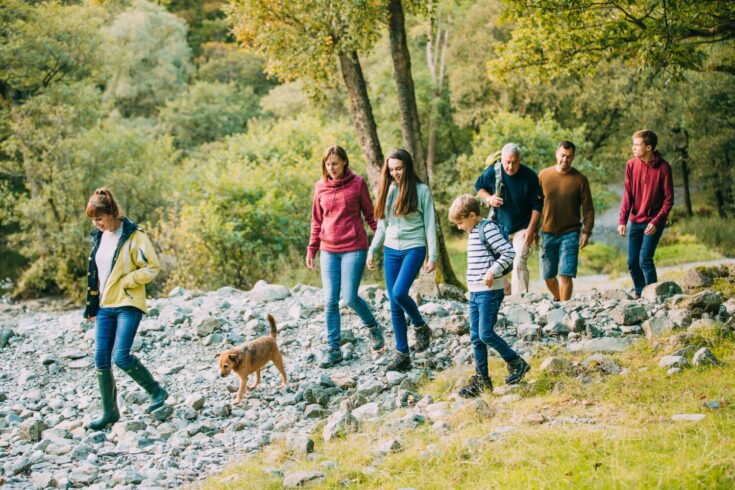A walking project funded by AHRC examines, through a UK-wide survey, where people and artists can share their lockdown walking experiences.
Self-confessed lover of the outdoors, Professor Deirdre Heddon from the University of Glasgow, is leading the walking publics/walking arts: walking, wellbeing and community during COVID-19 project in collaboration with academics from:
- University College Cork
- University of Liverpool
- University of East London.
In addition to wellbeing and community, the project funded by the Arts and Humanities Research Council (AHRC) as part of the UK Research and Innovation rapid response to COVID-19, will also look at the role of creativity, or creative walking, in those experiences.
Professor Heddon says:
There’s that sense of embodiment, isn’t there, with walking, even a sort of virtual embodiment if you are not actually physically walking, or if you can only walk 200 metres, how do you make that walk interesting every day when it’s the same 200 metres?
Survey open to take part in today
Already academics have been finding examples of walking experiences and creativity across the UK, including:
- colourful stone trails created for and by children
- fairy trails which have transformed local woods into sites of enchantment.
To now gauge people’s experiences, key to the project is a UK-wide survey, and everyone can take part today.
Professor Heddon, for whom a sense of embodiment within walking is very much entwined with her academic career in theatre studies, explained:
The survey opened on 21 April 2021 and closes on 21 May 2021, and we’re calling for as many people in the UK as possible to take part.
My own interest stems from thinking about walking as a cultural and creative practice, and then engaging in walking as an artist myself. The research team attached to this project comes with an arts-practice background, so we’re very much the creative researchers. We are all members of the Walking Artists Network, which was founded by my research collaborator on the project, Clare Qualmann.
There are two aspects to the survey. So, with the public one we really want to know how people have walked and, importantly, how they felt about walking – and of course why they haven’t walked. This is about understanding their experiences in walking and how that’s perhaps changed over the year. We are also interested in finding out if they have engaged in any creative activities while walking, or encountered any creative acts.
With artists, we want to hear how they have used walking in their creativity, how they’ve adapted and whether they had to abandon their plans entirely because it was no longer feasible, for example. Of course, many theatre artists can’t work in theatres anymore, so they may have turned to walking.
Connection and the meaning of walking
For Professor Heddon and the academic team, walking means many things, from not walking to imagining walking, and even to the very memory of movement, all bound with the thread of connection.
Professor Heddon explained:
This survey is about understanding through COVID-19 one critical aspect that, as humans, binds us in times of hardship: connection.
We came to this project already with some sense of the possibility of walking as a route to connection and community building, and also as a way to be in an environment. So when people leave those little things on a walk for others to find, it connects us, even though we may not have seen each other.
Walking can be done in wheelchairs and via other mobility aids. Walking can also be done in the mind with an imaginative or mindful walk, or a memory walk, for example.
And there are also those who haven’t been able to get out during lockdown, and we’re so keen to hear from them, too. Health perhaps, lack of access, can prevent walking. It can be very different for people – imagine if you’re in a high rise flat with small children and you are nervous of using the lift because of COVID-19.
Continuity through community
Once the survey results are all in, researchers want to use the data and experiences to demonstrate the impact of walking, and creative walking. This will help to put it into continued practice within the community.
Professor Heddon said:
We hope the project will help more people to access walking and the benefits of walking.
We want it to aid cultural and arts organisations to think of walking as a cultural activity which needs to develop now as we slowly come out of lockdown. Also, as a sort of sense of resilience and safety that we can draw on should there be any future restrictions.
We will be leading the commissioning of research and development into prototypes, and as part of that, we want to build a digital gallery that will showcase artists’ work.
There will also be a free, downloadable toolkit which we will develop with our partners and artists. This will draw on artists’ expertise that will again be intended to support more people to walk in whatever form that comes.
Additional information
How to take part in the survey today
To share your experiences of walking during COVID-19, whether you are an avid walker or a reluctant walker, simply complete the survey via the project’s website.
If you are an artist who has used walking as a resource, the project team would like to hear from you today through the website.
The survey closes on 21 May 2021.
The Walking Project research team
Collaborative research: meet The Walking Project research team:
- Professor Deirdre Heddon, James Arnott Chair in Drama at the University of Glasgow
- Professor Maggie O’Neill, Professor in Sociology & Criminology at University College Cork
- Dr Morag Rose, Lecturer in Human Geography at the University of Liverpool
- Clare Qualmann, Senior Lecturer in Performing Arts at the University of East London
- Dr Harry Wilson, Research Associate in Theatre Studies, at the University of Glasgow.
Last updated: 23 January 2023

